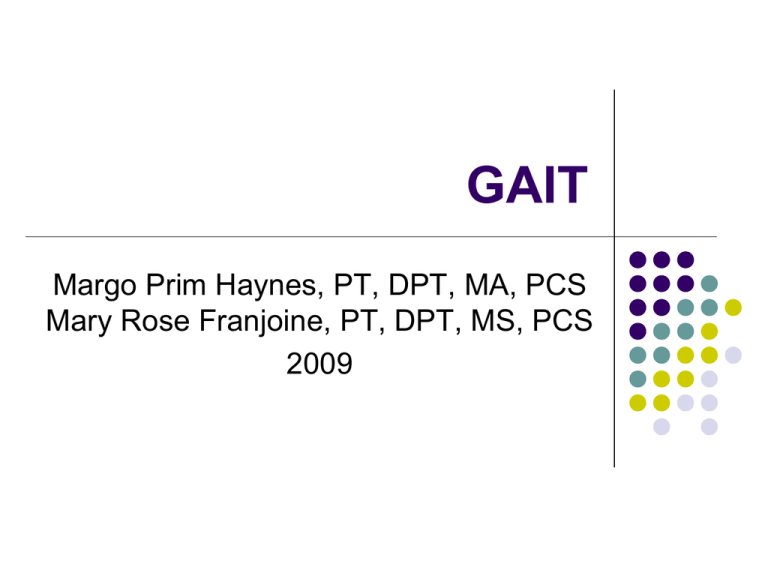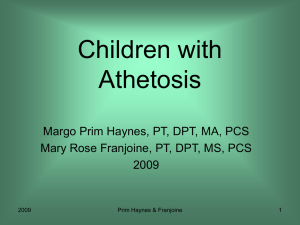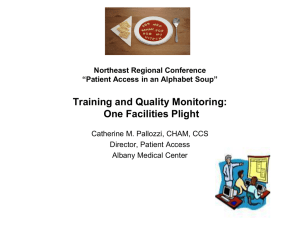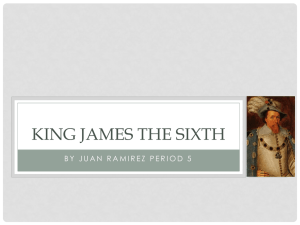GAIT - ndtpediatrictherapy
advertisement

GAIT Margo Prim Haynes, PT, DPT, MA, PCS Mary Rose Franjoine, PT, DPT, MS, PCS 2009 Overview 2009 Definitions Video of typical gait Developmental changes Gait cycle Ground reaction force vectors Atypical gait Lab Margo Prim Haynes & Mary Rose Franjoine Learning Objectives At the conclusion of this lecture the learner will: 1. Describe the characteristics of early gait. 2. Describe the key developmental factors that influence the development and refinement of gait. 3 . Identify and describe the characteristics of typical gait differentiating components of stance phase from swing phase. 4. Visually identify key components of typical gait. 5. Describe the impact of ground reaction forces on the stance limb. 6. Discriminate typical from atypical components of gait. 7. Design intervention strategies to address key impairments that contribute to an atypical gait pattern. Margo Prim Haynes & Mary Rose Franjoine An Early Walker Video Clip 2009 Margo Prim Haynes & Mary Rose Franjoine Characteristics of Early Gait BOS wider than hips, therefore hindfoot pronation (eversion) results Contact with floor occurs with foot flat Heel to toe gait develops by 2 yrs/ process complete by 3.5 yrs Uneven step length 2009 Margo Prim Haynes & Mary Rose Franjoine Characteristics of Early Gait Hyperextension of knees throughout stance phase Greater ant.-post. pelvic movement Less lateral (pelvic tilting ) & rotational pelvic movement 2009 Margo Prim Haynes & Mary Rose Franjoine Characteristics of Early Gait 2009 Greater hip & knee flexion with abduction & external rotation of hip and tibia during swing phase Margo Prim Haynes & Mary Rose Franjoine Characteristics of Early Gait 2009 Upper Extremities (UE) in high, medium, then low guard with improved trunk balance Reciprocal arm swing developing at 18 months Margo Prim Haynes & Mary Rose Franjoine Kinematic Changes between 1 - 7 Years of Age ↑ duration of single limb stance (esp. to 2.5 yrs) ↑ walking velocity (esp. to 3.5 yrs) ↓ cadence and its variability ↑ step length (esp. to 2.5 yrs) Ratio of body width to stride width: ↑s rapidly until 2.5 yrs, more slowly to 3.5 yrs, then plateaus 2009 Margo Prim Haynes & Mary Rose Franjoine Indicators of Mature Gait 2009 Greater % time in single limb stance with increased limb length and stability Increased velocity Decreased cadence Greater step length Decreased base of support Margo Prim Haynes & Mary Rose Franjoine Gait Video 2009 Margo Prim Haynes & Mary Rose Franjoine 40% of cycle 60% of cycle 2009 Margo Prim Haynes & Mary Rose Franjoine Perry 1992 Gait Cycle Typical walking has 50-60 steps taken per minute Two phases 2009 Stance phase Swing phase Margo Prim Haynes & Mary Rose Franjoine Stance Phase 2009 Heel contact (weight acceptance) to toe off 60% of gait cycle Margo Prim Haynes & Mary Rose Franjoine Swing Phase 2009 Toe off to before heel strike 40% of gait cycle Margo Prim Haynes & Mary Rose Franjoine Quiet Standing Slow shifting of body weight between limbs due to cardiac dynamics & lack of absolute proprioception Feet generally parallel COG slightly anterior to the ankle joint 2009 Tendency for trunk to move forward & plantarflexors (pf) must hold to stand in place To move, pf must “let go” (very difficult for children to do with CP as they rely on extension to stay up) Margo Prim Haynes & Mary Rose Franjoine Functional Phases of Gait Stance Phase (60%) 2009 Initial contact Loading response Single limb stance Midstance Terminal stance Pre-swing=toe off Swing Phase (40%) Pre-swing Initial swing Midswing Terminal swing Margo Prim Haynes & Mary Rose Franjoine Initial Contact The instant at which foot touches floor Ankle locked in supination 2009 Adduction, inversion, and plantarflexion Margo Prim Haynes & Mary Rose Franjoine Loading Response Begins immediately after heel contact (heel strike) & continues until other foot is lifted for swing (foot flat) Ankle unlocked in pronation (abduction, eversion, and dorsiflexion Double Stance Deceleration 2009 Margo Prim Haynes & Mary Rose Franjoine Single Limb Stance 2009 Period of time when opposite limb is going through swing phase Foot/ankle moves to locked position of supination preparing the foot and ankle for push off. Margo Prim Haynes & Mary Rose Franjoine Weight bearing Surface of Foot 2009 At heel contact, weight is lateral to the midline of the heel Weight moves forward in a straight line towards head of third metatarsal Then weight shifts medially to allow push off from first metatarsal head when initial swing begins Margo Prim Haynes & Mary Rose Franjoine Weight Bearing Surface of foot 2009 Margo Prim Haynes & Mary Rose Franjoine Pre-Swing 2009 Begins with initial contact of opposite limb and ends with ipsilateral toe-off Margo Prim Haynes & Mary Rose Franjoine Initial Swing 2009 Begins with lift of the foot from the floor and ends when swinging foot is opposite the stance foot Margo Prim Haynes & Mary Rose Franjoine Midswing 2009 Begins when swing limb is opposite stance limb and ends when swinging limb is forward and tibia is vertical Margo Prim Haynes & Mary Rose Franjoine Terminal Swing 2009 Begins with vertical tibia and ends when foot contacts (strikes) the floor Margo Prim Haynes & Mary Rose Franjoine Sinusoidal Pattern Limb motion during walking is based on maintaining a symmetric and low amplitude displacement of the center of gravity (COG) in the lateral and vertical directions. 2009 Initial Contact Double limb support Midstance Margo Prim Haynes & Mary Rose Franjoine Sinusoidal Pattern 2009 Margo Prim Haynes & Mary Rose Franjoine Perry, 1992 Sinusoidal Pattern COG: 2009 Lowest during initial contact Central and low during double limb support Highest and most lateral in midstance Moves 4 cm medial-lateral shift, 2 cm vertical shift Margo Prim Haynes & Mary Rose Franjoine Ground Reaction Force Vectors (GRFV) Determines the stability or instability by relating alignment of GRFV to the joint centers Ankle gains stability with 5° dorsiflexion Three forces (body vectors) 2009 Falling body weight Ligamentous tension Body vector as passive stability when the joints are hyperextended Margo Prim Haynes & Mary Rose Franjoine Body vector as passive stability when the joints are hyperextended Joints are locked by body weight vector on one side and ligamentous tension on the other. This explains the posture of the child with hypotonicity ← iliofemoral ligament Posterior oblique ligament → 2009 Margo Prim Haynes & Mary Rose Franjoine Perry 1992 Ground Force Reaction Vector Initial contact to loading 2009 Margo Prim Haynes & Mary Rose Franjoine Perry 1992 Muscle Activation 2009 Margo Prim Haynes & Mary Rose Franjoine Perry 1992 Critical Events for: Initial 2009 contact is heel first contact Margo Prim Haynes & Mary Rose Franjoine Critical Events for: Loading response is hip stability, controlled knee flexion, and plantarflexion 2009 Margo Prim Haynes & Mary Rose Franjoine Ground Force Reaction Vector 2009 Margo Prim Haynes & Mary Rose Franjoine Perry 1992 b Muscle Activation (muscles are more balanced, therefore less hard work) 2009 Margo Prim Haynes & Mary Rose Franjoine Perry 1992 b Critical Events is: Controlled tibial advancement to create a forward fall position. 2009 Margo Prim Haynes & Mary Rose Franjoine Ground Force Reaction Vector 2009 Margo Prim Haynes & Mary Rose Franjoine c Perry 1992 Muscle Activation 2009 Margo Prim Haynes & Mary Rose Franjoine c Perry 1992 Critical Events is to have Ankle locked in dorsiflexion with heel rise; trailing limb Ankle mobility (This is where the children with plantarflexion contractures have problems) 2009 Margo Prim Haynes & Mary Rose Franjoine Gait Analysis 2009 Observation Pedograph Motion analysis Dynamic electromyography Force plate recordings Energy cost measurement Margo Prim Haynes & Mary Rose Franjoine Five Determinants of Gait 1. 2. 3. 4. 5. 2009 Lateral pelvic movement (gluteus medius prevents positive Trendelenberg) Rotational pelvic movement (one side moves forward of the other side to minimize vertical shift of the COG, allows for stride length) Knee flexion(allow for limb length adjustment) Knee/ankle/foot interactions (minimizes the vertical shift of the COG) Physiologic valgus (narrows BOS) Margo Prim Haynes & Mary Rose Franjoine Five Determinants of Gait 1. Lateral pelvic movement (gluteus medius prevents positive Trendelenberg) 2. Rotational pelvic movement (one side moves forward of the other side to minimize vertical shift of the COG, allows for stride length) Knee flexion(allow for limb length adjustment) Knee/ankle/foot interactions (minimizes the vertical shift of the COG) Physiologic valgus (narrows BOS) 3. 4. 5. 2009 Margo Prim Haynes & Mary Rose Franjoine Five Determinants of Gait 1. Lateral pelvic movement (gluteus medius prevents positive Trendelenberg) 2. Rotational pelvic movement (one side moves forward of the other side to minimize vertical shift of the COG, allows for stride length) 3. Knee flexion(allow for limb length adjustment) Knee/ankle/foot interactions (minimizes the vertical shift of the COG) Physiologic valgus (narrows BOS) 4. 5. 2009 Margo Prim Haynes & Mary Rose Franjoine Five Determinants of Gait 1. 2. Lateral pelvic movement (gluteus medius prevents positive Trendelenberg) Rotational pelvic movement (one side moves forward of the other side to minimize vertical shift of the COG, allows for stride length) 3. Knee flexion(allow for limb length adjustment) 4. Knee/ankle/foot interactions (minimizes the vertical shift of the COG) Physiologic valgus (narrows BOS) 5. 2009 Margo Prim Haynes & Mary Rose Franjoine Five Determinants of Gait 1. 2. 3. Lateral pelvic movement (gluteus medius prevents positive Trendelenberg) Rotational pelvic movement (one side moves forward of the other side to minimize vertical shift of the COG, allows for stride length) Knee flexion(allow for limb length adjustment) 4. Knee/ankle/foot interactions (minimizes the vertical shift of the COG) 5. Physiologic valgus (narrows BOS) 2009 Margo Prim Haynes & Mary Rose Franjoine Five Determinants of Gait 4. Lateral pelvic movement (gluteus medius prevents positive Trendelenberg) Rotational pelvic movement (one side moves forward of the other side to minimize vertical shift of the COG, allows for stride length) Knee flexion(allow for limb length adjustment) Knee/ankle/foot interactions (minimizes the vertical shift of the COG) 5. Physiologic valgus (narrows BOS) 1. 2. 3. 2009 Margo Prim Haynes & Mary Rose Franjoine Bibliography 2009 Perry J: Gait Analysis Normal and Pathological Function, NJ: SLACK Inc. 1992 Shumway-Cook & Woollacott: Motor Control Theory and Practical Applications, Baltimore: Williams & Wilkins, 1995 Sutherland D: Gait Disorders in Childhood and Adolescence, Baltimore: Williams & Wilkins, 1984 Weber & Weber: Mechanics of the Human Walking Apparatus, Berlin: Springer-Verlag, 1992 Margo Prim Haynes & Mary Rose Franjoine Original Template designed by: 2009 Margo Prim Haynes, PT, DPT, MA, PCS Jane Styer Acevedo, PT Margo Prim Haynes & Mary Rose Franjoine










